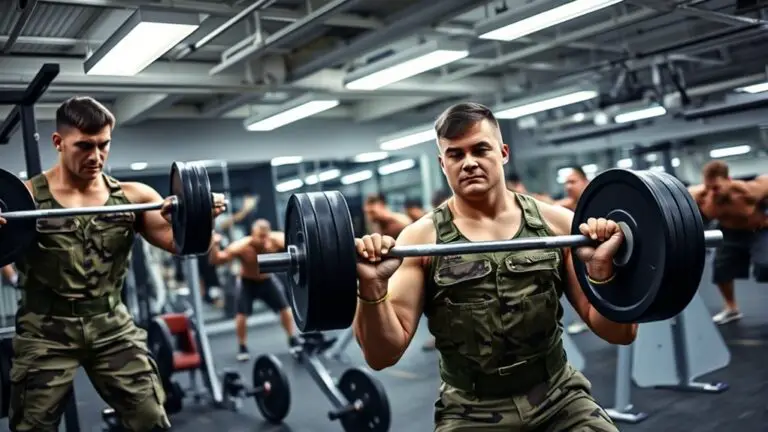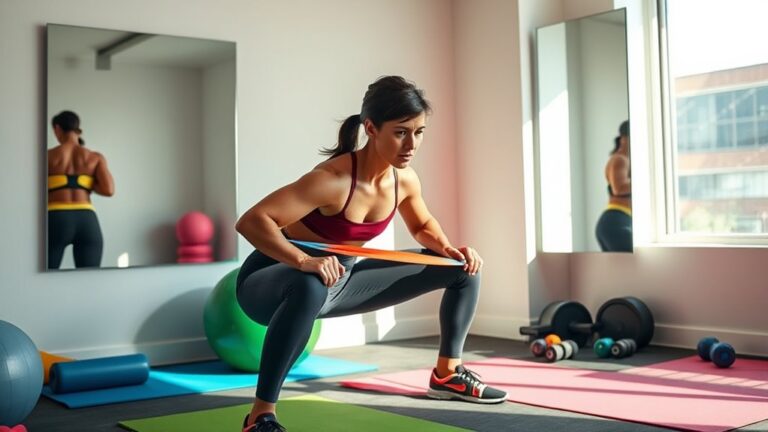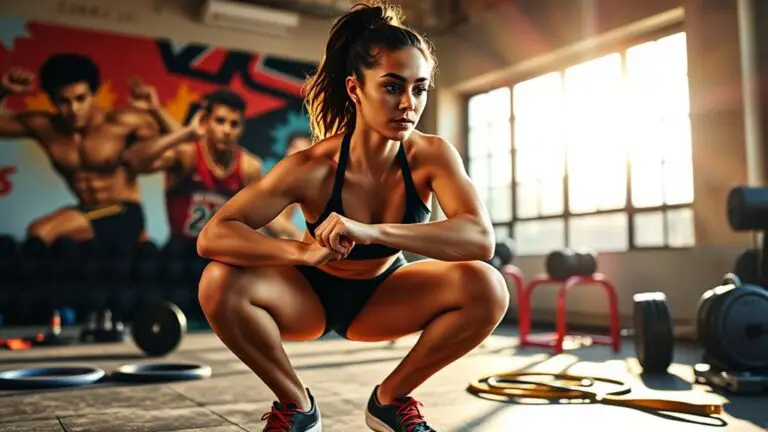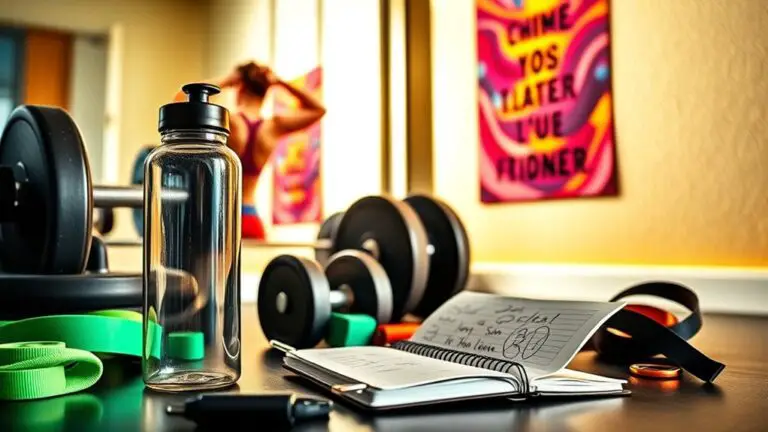The Best Gym Workouts for People With Disabilities
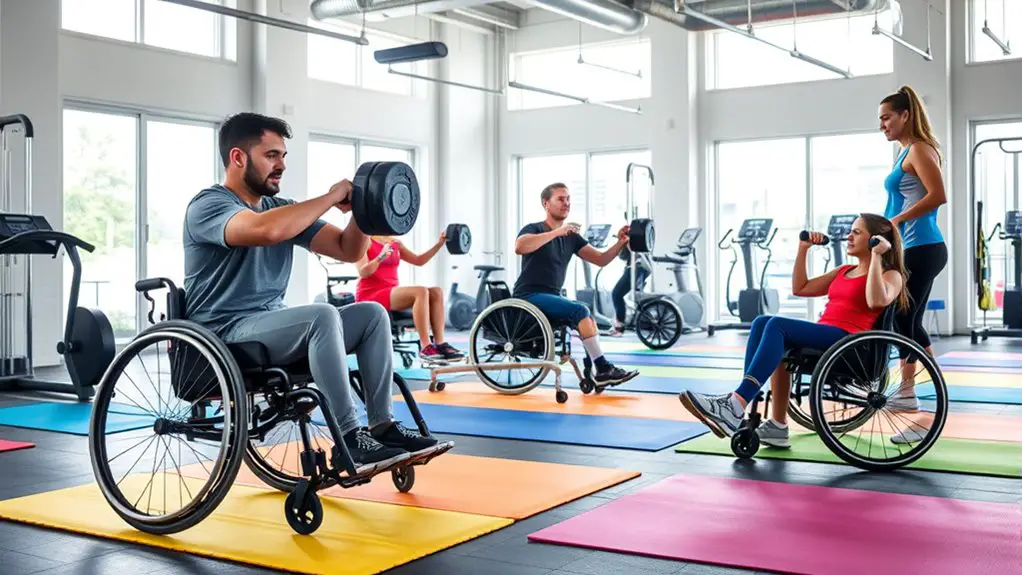
The best gym workouts for people with disabilities focus on adaptive fitness, ensuring safety and inclusivity. Think strength training with accessible equipment, tailored cardio options like recumbent bikes, and gentle flexibility exercises that enhance mobility. Group classes foster community support, while personalized goals keep you motivated. It’s all about fitting exercises to your unique needs. Discover how a well-designed workout environment can enhance your fitness journey, allowing you to reach new heights in your health and wellness.
Understanding Adaptive Fitness
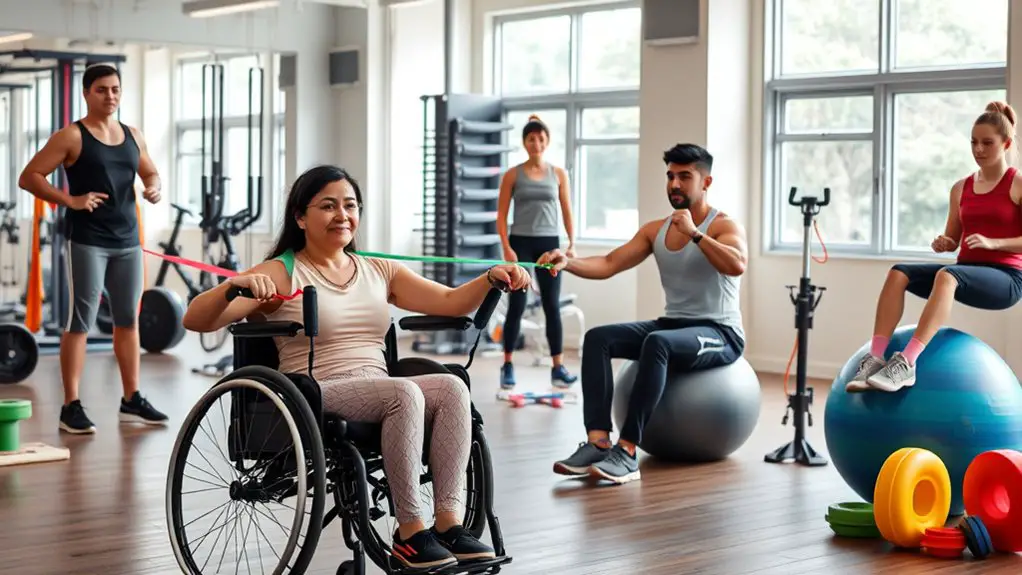
Understanding adaptive fitness is fundamental for anyone looking to stay active, especially if you have a disability. Adaptive exercise focuses on modifying workouts to accommodate individual needs, guaranteeing you can participate safely and effectively. This approach encourages you to explore various movements that fit your abilities, helping you build strength, flexibility, and endurance.
Inclusive training environments are essential. They promote a sense of belonging while providing the necessary support and resources. When you engage in adaptive fitness, you’re not just improving your physical health; you’re also enhancing your mental well-being.
Always start with a warm-up to prevent injuries, and listen to your body during workouts. It’s important to consult with a fitness professional experienced in adaptive exercise to create a tailored program. This guarantees you’re exercising safely and enjoying the process. Embrace adaptive fitness as a way to empower yourself and discover new possibilities in your fitness journey.
Strength Training for All Abilities
When it comes to strength training, there’s no one-size-fits-all approach. You can use adaptive strength equipment designed for various abilities, and customize your workout plans to meet your unique needs. Let’s explore how these options can empower your fitness journey.
Adaptive Strength Equipment
Adaptive strength equipment opens up a world of possibilities for individuals with disabilities, empowering you to engage in effective strength training. With the latest adaptive equipment innovations, you can find machines tailored to your specific needs. Accessible gym design guarantees that these tools are not only easy to use but also safe, promoting a secure workout environment. Look for equipment that features adjustable settings, user-friendly interfaces, and supportive structures. These innovations help accommodate various abilities, allowing you to build strength at your own pace. Remember, safety should always be your top priority, so familiarize yourself with the equipment before starting. With the right adaptive strength equipment, you’ll have the confidence to pursue your fitness goals and enjoy the journey.
Customized Workout Plans
Creating customized workout plans tailored to individual abilities can greatly enhance your strength training experience. Personalized training focuses on your unique needs, ensuring you’re comfortable and safe while working out. Start by evaluating your current fitness level and any physical limitations. This way, you can choose the right exercises that promote strength without risking injury.
Incorporate accessibility options like adjustable equipment, resistance bands, or bodyweight exercises to maximize your workouts. A fitness professional can help design a plan that aligns with your goals, whether it’s building strength, improving mobility, or increasing endurance. Remember, consistency is key, but always listen to your body. Adjust your routine as needed to stay motivated and safe, making your strength training journey both effective and enjoyable.
Cardiovascular Workouts for Everyone
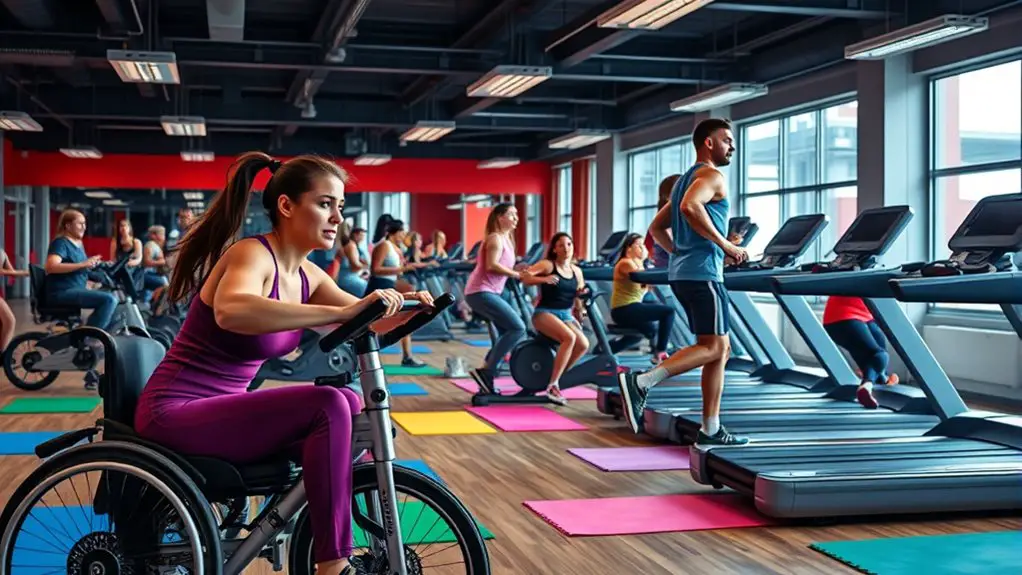
When it comes to cardiovascular workouts, there are plenty of options designed for everyone, regardless of ability. Adaptive cardio equipment can make a big difference in your routine, allowing you to engage in effective workouts. Plus, inclusive group classes create a supportive environment where you can connect with others while getting your heart pumping.
Adaptive Cardio Equipment
Cardiovascular fitness is essential for everyone, regardless of ability, and adaptive cardio equipment makes it accessible to all. These adaptive machines are designed to accommodate various needs, guaranteeing you can safely engage in cardio workouts. Look for options like recumbent bikes, hand cycles, and seated ellipticals, which provide effective cardiovascular exercise while promoting fitness accessibility.
Always check that equipment is adjusted correctly before use to guarantee your comfort and safety. Many gyms offer staff assistance, so don’t hesitate to ask for help. Remember, the goal is to find a workout that suits you, allowing you to build endurance and improve overall health. With the right adaptive cardio equipment, you can enjoy a fulfilling and safe fitness journey.
Inclusive Group Classes
Inclusive group classes offer a fantastic way to engage in cardiovascular workouts while enjoying the support of a community. These classes are designed for all abilities, ensuring everyone feels welcome and safe. Here are some options you might consider:
- Adaptive Yoga: Gentle movements that enhance flexibility and strength, tailored to your needs.
- Inclusive Dance: A fun way to get your heart rate up while expressing yourself through rhythm and movement.
- Water Aerobics: Low-impact exercises in a controlled environment, perfect for joint safety.
- Group Cycling: Adapted bikes allow you to pedal at your own pace, encouraging social interaction and motivation.
Joining these classes not only boosts your fitness but also fosters a sense of belonging.
Flexibility and Mobility Exercises
Although you might face unique challenges, incorporating flexibility and mobility exercises into your routine can considerably enhance your overall physical well-being. These exercises help improve your range of motion, reduce muscle tension, and prevent injuries. Start with gentle stretching techniques, focusing on major muscle groups like your arms, legs, and back. Always listen to your body and avoid pushing yourself too hard, as safety is key.
Consider integrating mobility routines that involve movement through various planes. Simple exercises like seated leg lifts or arm circles can be effective. You can also use resistance bands to assist with stretches, providing support as you work on your flexibility. Remember to breathe deeply during each stretch, allowing your muscles to relax. Consistency is essential—aim for short sessions several times a week to reap the benefits. Your commitment to these exercises can lead to greater mobility and a better quality of life.
Group Classes and Community Support
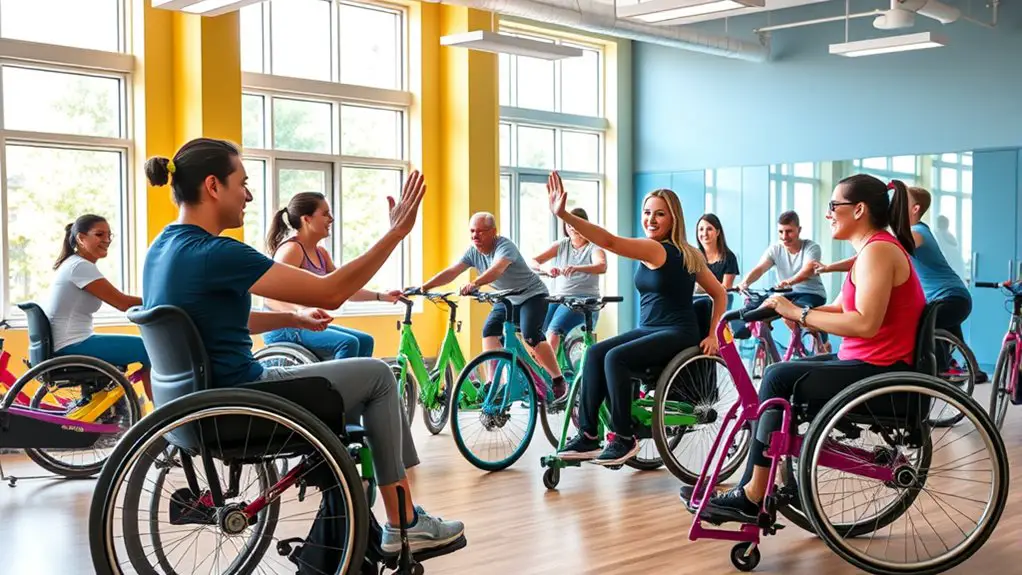
Participating in group classes can be a game changer for anyone with disabilities, as it not only fosters a sense of community but also provides motivation and accountability. Joining a supportive environment can enhance your fitness journey through:
- Peer Support: Connecting with others who share similar challenges can help you feel understood and encouraged.
- Structured Workouts: Classes led by trained instructors guarantee that exercises are safe and tailored to your needs.
- Social Engagement: Building friendships in a group setting promotes mental well-being and can make workouts more enjoyable.
- Consistent Routine: Regular classes help you stay committed to your fitness goals, providing that extra push to show up.
Tips for Creating an Inclusive Workout Environment
Creating a welcoming workout environment is essential for everyone, especially those with disabilities. Start by ensuring your gym features accessible design. This means having ramps, wide doorways, and equipment that accommodates various needs. Clearly marked pathways and accessible restrooms also play a vital role in safety and ease of movement.
Incorporate sensory considerations to enhance comfort. Offer quiet areas for those who may feel overwhelmed by noise and bright lights. Adjustable lighting and sound levels can make a big difference.
Encourage staff training focused on inclusivity, so everyone feels supported and understood. Display clear signage and visual aids to help individuals navigate the space confidently.
Lastly, invite feedback from your members to continually improve the environment. An inclusive atmosphere fosters community and encourages everyone to reach their fitness goals safely. By prioritizing these elements, you’ll create a gym that truly welcomes all.
Frequently Asked Questions
What Equipment Is Best for Adaptive Fitness Workouts?
When considering the best equipment for adaptive fitness workouts, you’ll want to focus on adaptive equipment that offers inclusive designs. Look for items like resistance bands, stability balls, and modified weight machines that guarantee safety and comfort during your workouts. Additionally, consider using accessible cardio machines, like hand cycles or recumbent bikes, which can accommodate various needs. Prioritizing safety will help you enjoy your fitness journey while achieving your goals effectively.
How Can I Track My Progress in Adaptive Workouts?
Tracking your progress in adaptive workouts can be as satisfying as watching a garden bloom. You can start by keeping a journal or using apps designed for progress tracking, noting your achievements with adaptive techniques. Consider setting small, achievable goals to monitor improvements safely. Regularly reflect on your workouts to see how far you’ve come, and don’t hesitate to adjust your methods to guarantee you’re comfortable and safe throughout your journey.
Are There Specific Certifications for Adaptive Fitness Trainers?
Yes, there are specific adaptive fitness certifications designed for trainers who want to use inclusive training techniques. These certifications guarantee that trainers have the knowledge to create safe and effective workouts for individuals with diverse needs. When choosing a trainer, look for those with recognized adaptive fitness certifications, as they’ll be better equipped to help you reach your goals while prioritizing your safety and well-being during your fitness journey.
Can I Participate in Sports Activities With a Disability?
Absolutely, you can participate in sports activities with a disability! There are plenty of adaptive sports and inclusive activities designed just for you. It’s important to choose options that match your abilities and interests while ensuring your safety. Many organizations offer programs that cater to various skill levels, so you’ll find supportive environments to thrive. Always consult with a coach or trainer to find the best fit for your needs and stay safe while enjoying sports!
How Do I Find a Local Adaptive Fitness Community?
Finding a local adaptive fitness community can be rewarding and empowering. You can start by searching online for adaptive fitness groups in your area. Social media platforms often have pages dedicated to inclusive fitness. Don’t forget to check community resources like local gyms or recreation centers, which might offer adaptive programs. Attending events or meetings can also help you connect with others who share your interests and prioritize safety while staying active.

